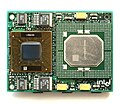Intel overdrive
Under the name Intel OverDrive , the company Intel marketed processors between May 1992 and 1998 that were intended for upgrading systems with older CPUs.
history
i486 OverDrive
An Intel i486 overdrive processor is intended for upgrading existing 80486 systems and is a special version of the respective i486DX2 , i486SX2 and Intel DX4 processors.
In order for these overdrive processors to run in the older system environment, they have a predefined clock multiplication and ignore the external settings of the multiplier. In addition, they basically work with a 5 V power supply. In the case of the overdrive version of the Intel DX4, there is a voltage converter on the processor surface that generates the necessary processor operating voltage of 3.3 V from the existing 5 V voltage.
The first OverDrive processor is an i486DX2 introduced in May 1992, which can be operated in an i486SX motherboard. This means that such a system can be retrofitted with an FPU that the i486SX lacks. The remaining variants of the i486 were then offered as OverDrive-CPU.
Pentium OverDrive
The one Intel Pentium overdrive 83 MHz (base 3)
The last OverDrive processors for 486 motherboards are the Pentium OverDrive with 63 MHz (PODP5V63) or 83 MHz (PODP5V83). They require a motherboard with a ZIF socket - although the majority of the socket 3 boards sold are prepared with a corresponding socket - and are no faster than the comparable 80486 -compatible Am5x86 and Cyrix 5x86 processors from the AMD and Cyrix rivals . For these reasons and the late market launch, the product flopped for socket 3.
The situation was different with Socket 4 : The original Pentium from Intel for Socket 4 worked with a higher operating voltage and a lower clocked front side bus with 60 or 66 MHz. Not only the operating voltage, but also the mechanically incompatible socket 4 prevented the use of the more recent Pentium CPUs (P54, socket 5/7, 3.3 V) and were therefore not an inexpensive upgrade alternative. That's why Intel offered the lesser-known Pentium Overdrive PODP5V133 with a fixed multiplier of 2 for socket 4. This resulted in a clock frequency of 120 MHz or 133 MHz.
Pentium MMX OverDrive
There are also Pentium MMX processors for socket 5 and socket 7 boards. These CPUs have their own electronics and a permanently attached fan.
Pentium II OverDrive
The last Intel product to be called OverDrive is the Pentium II OverDrive, which can be operated in a Pentium Pro socket. The Pentium II OverDrive was criticized for the fact that it cannot be used to upgrade large multiprocessor systems , as it can only be operated in systems with a maximum of two CPUs. There are two versions, with 300 MHz with a 5-fold bus clock of 60 MHz and with 333 MHz with a 5-fold bus clock of 66 MHz. The higher clock multiplier is generated in the processor.
Technical features
With the CPUs of the type i486, the computing power can only be improved by increasing the processor speed. However, since the processor clock is permanently linked to that of the system in a motherboard that was customary at the time, a CPU cannot easily be replaced by a similar, higher clocked one. The CPUs of the i386 series , the predecessors of the i486, are upgraded by inserting a complete daughterboard that runs the CPU at a high rate and addresses the main board with the system rate. The OverDrive CPUs, on the other hand, contain the necessary components themselves. In addition, they can be operated in other sockets than those provided for the corresponding CPU without OverDrive. With the i486 CPUs there is an alternative option of using an intermediate socket to replace a CPU with a higher clocked CPU.









